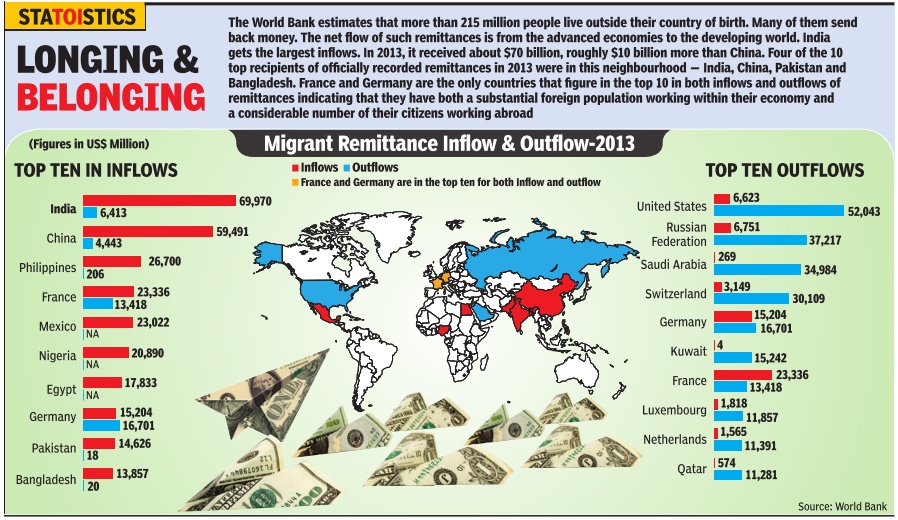Remittances: South Asia
This is a collection of articles archived for the excellence of their content. |
Contents |
Quantum of remittances
2012
See graphic, 2012: Top 25 source countries
BRIDGING THE GULF
The Times of India Dec 01 2014
India gets the highest amount of remittances in the world at roughly $70 billion, almost three times the amount of FDI that comes into the country. Where does all this money come from? Data shows that the bulk of remittances come from three different categories of countries: Middle Eastern monarchies such as Qatar, Western developed nations such as the US or Australia, and next door neighbors such as Bangladesh and Nepal. By far the largest amount comes from the Gulf countries -Qatar, Bahrain, Oman, Saudi Arabia, and Kuwait -which sent a combined $32.7 billion, almost half of all remittances received.
Migrant remittances: 2013

From: The Times of India
See graphic
Migrant remittances: South Asia and the world
2017

ii) Top ten remittance receivers in 2017
From: May 9, 2018: The Times of India
See graphic:
i) Countries most dependent on overseas population;
ii) Top ten remittance receivers in 2017
Remittances: Inward and reverse
The Times of India, Dec 03 2015
Vibhor Mohan Reverse Remittances: Survey Finds 9% Of Punjabi Households Send Money Abroad
The success of NRIs is often judged by the amount of money they send back home as remittances.But now, perhaps for the first time, an out-migration survey of 10,000 households in Punjab has found that 9% of them send money to their relatives in different parts of the world.
As expected, 71% of the respondents having family members abroad confirmed regular receipts. But that a substantial number send money outside India -reverse remittance -indicates that the foreign dream may not always be as rosy as it is made out to be.
The study -`Dynamics of International Out-Migration from Punjab', sponsored by the Centre for Research in Rural and Industrial Development (CRRID), Chandigarh and the Institut Nation al d'Études Démographiques (INED), Paris -points out that among those doing re verse remittance, the highest rates were recorded among households with a large landholding (21%).
“Reserve remittance is a relatively untouched aspect of the migration story and even the Central government often doesn't have figures on it,“ said Professor Aswini Kumar Nanda of CRRID, who conducted the study with Jacques Véron (INED). “There are households in Punjab that are obsessed with the idea of settling their child abroad and would sell off property to realise this dream.“
Households with the highest standard of living (14%), those in south Punjab's Malwa region (13%) and general caste (non-SCnonOBC) households (12%) are among those that show reserve remittance.
“Such a pattern of reverse remittance among the households with out-migration experience points to a presence of a section of wealthy or highly networked emigrants -with capacity to raise required resources from market or non-market sources,“ says the report.
Around one-tenth of all the surveyed households in Punjab received remittances at some point. NRI-rich Doa ba -Hoshiarpur, Kapurthala, Jalandhar and Nawanshahr -reports higher incidence of remittance receipts (21%).
If, instead of all households only those that have at least one current interna tional out-migrant are considered, the incidence of remittances increases substantially -from 10% to 71%. The study reveals that three-fifths (roughly 6,000) of households send money abroad to meet the immediate needs of the `departing' member or to provide some support initially after landing on foreign soil for accommodation, food, communica tion, clothing and transport.
69% of families `3L to sent `1.5L-` kin abroad earlier
Data indicates that during the five-year period before the survey, 69% of households sending remittances abroad had sent up to a total of Rs 1.5 lakh each, followed by 23% of households sending amounts ranging from Rs 1.5 lakh to Rs 3 lakh each. The share of households with high volume of reverse remittance (more than Rs 3 lakh) was estimated to be around 8%.
Also, 12% of households received as little as Rs 10,000 or even less as transfer receipts from their family members or relatives abroad.
Remittances used for daily needs, debt repayment
Four-fifths of the households used remittances for day-to-day consumption (including for food, fuel, clothing, footwear, etc.), followed by two-fifths for debt repayment.
Also, 34% and 31% of the households used income from abroad for seeking health care and education.
Remittances are also used for savings, housing (construction, repair and renovation) and social ceremonies such as weddings by 14%, 10% and 7% of households, respectively.
See also
Remittances: South Asia
